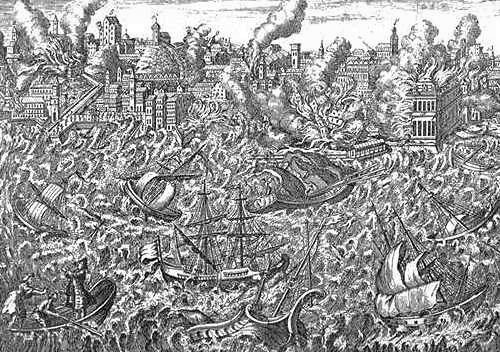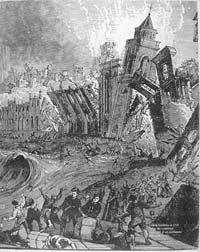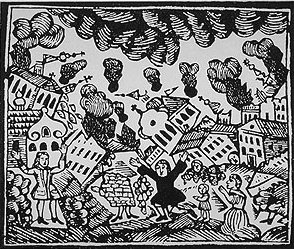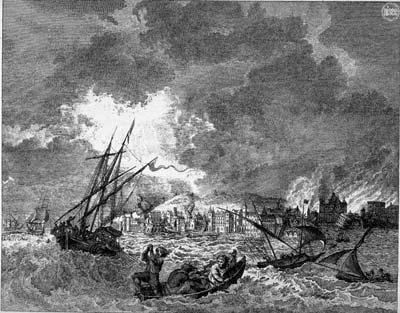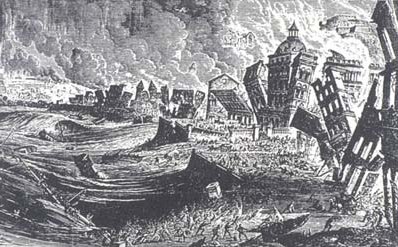Lisbon Earthquake
by Rob Zaretsky
Today, our guest, Rob Zaretsky reflects upon disaster, and how we react to it.. The University of Houston presents this series about the machines that make our civilization run, and the people whose ingenuity created them.
A great subterranean moan awakened the city of Lisbon on the first of November, 1755. It heralded the century's greatest earthquake. Awash in images of the Asian tsunami, we might consider the "Great Lisbon Earthquake." Is natural disaster what it used to be?
For nearly ten minutes, Lisbon was convulsed by great seismic heaves. They ripped apart the soil and buildings -- engulfed men, women and children. Great fires followed. Thousands of residents streamed to the port. Yet their refuge became another killing field. The harbor took a deep breath. The water emptied from it. It returned moments later in a series of tsunamis. They swept through the downtown area, then rushed back to sea. They carried, in the debris-spackled foam, hundreds of human victims.
Some 90,000 people died in Lisbon-more than one third of its population. Another 10,000 lives were lost in southwest Spain and Morocco. The tremors were felt as far away as Finland and Barbados.
The earthquake also pounded Europe's political and cultural landscapes. The oldest and brightest light of the Enlightenment, Voltaire, quickly published his Poem on the Lisbon Disaster:
Unhappy mortals! Dark and mourning earth!
Affrighted gathering of human kind!
Eternal lingering of useless pain!
Voltaire reveals, from those opening lines, the despair of a thinker who's stymied by the intellectual consequences of this event.
Soon after, he inserts the earthquake into Candide's absurdly catastrophic life. From a ship in Lisbon harbor, Candide watches helplessly as the good drown and the wicked survive. His friend Martin concludes that if the world has any purpose at all, it is to drive us mad.
Philosopher Susan Neiman reminds us that eighteenth century thinkers like Voltaire saw the Lisbon quake as a metaphysical event. For some, Lisbon lessened either God's beneficence or his power. For others, the quake lessened their estimation of human reason and a reasonable world. Nature, according to enlightened minds, was a benign and intelligible force. Its well-oiled operation reflected the intelligence and skill of a designer God. Could we, though, retain our confidence in reason, and thus in God's ways, in the rubble of Lisbon?
Today, there no longer seem to be any Voltaires questioning reason and nature, or, put baldly, addressing the problem of evil. Why? For Neiman, Lisbon signals the moment God was fully and finally exiled from public affairs. Portugal's prime minister responded to the quake by saying, "We will bury the dead and take care of the living." We have largely followed his example. We no longer turn inward in awe and turn outward with questions.
Instead, we turn to computer models for practical solutions and to the television for narrative resolutions. We mourn the vast thousands of lives lost in Asia. We also wonder if something has been lost in the technological gains that show us human torment in full and unremitting color?
I'm Rob Zaretsky, at the University of Houston, where we're interested in the way inventive minds work.
Robert Zaretsky is professor of French history in the University of Houston Honors College, and the Department of Modern and Classical Languages.
S. Neiman, Evil in Modern Thought: An Alternative History of Philosophy. (Princeton, NJ: Princeton University Press, 2002).
For Candide, we recommend the edition: F. M. Voltaire: Candide. (ed. Robert Adams) (New York: Norton Critical Editions, 1991).
Many period images of the Lisbon catastrophe are included on the web, generally without attribution. We presume that these artist's conceptions are from contempory now-long-out-of-print sources, and we include several of them below.
